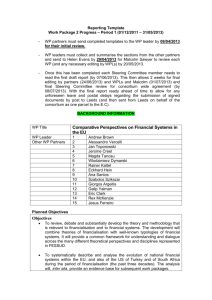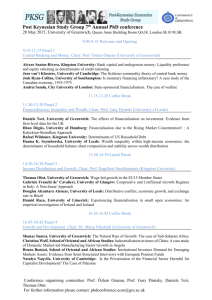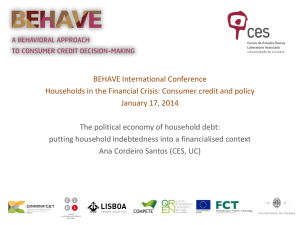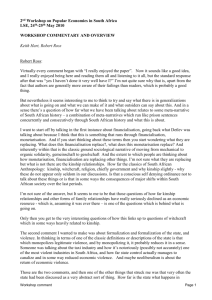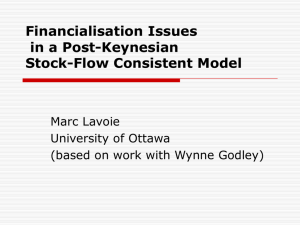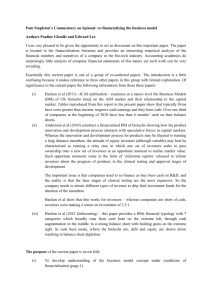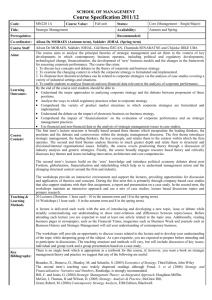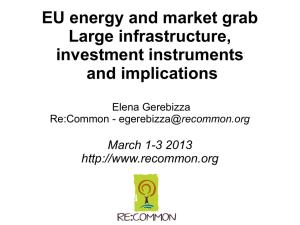Financialisation in
advertisement
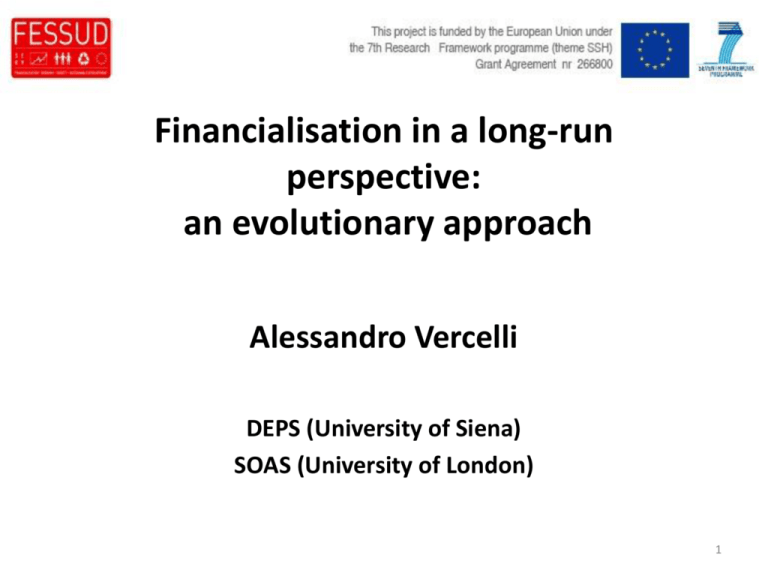
Financialisation in a long-run
perspective:
an evolutionary approach
Alessandro Vercelli
DEPS (University of Siena)
SOAS (University of London)
1
Three basic approaches
-specific historical episode
3 main options { -recurring phenomenon
-stage of a long-run process (or tendency)
In my opinion the three options do not exclude each other:
my suggested vision combines the three approaches within an evolutionary paradigm
2
Preliminary definition
I start from a broad definition that may accommodate all the stages of the process
Financialisation:
process of evolution of «money» (money/credit/finance) that increases its importance
and thus the influence of financial markets, institutions and élites
While we analyse the processes of financialisation we should keep in mind the crucial
money as quantity that is created, multiplied, hoarded and utilized
distinction {
money as structure shaping the forms of exchange / accumulation
3
Financialisation as a recurring phenomenon
significant analogies
recurring phenomenon in a broad sense {
significant differences
1st financialisation (about 1880-1929)
Since the industrial revolution {
2nd financialisation (about 1980-2014 → ?)
Under which conditions? Main answer: phase of long-term fluctuations:
long waves (e.g. Arrighi, 1994; Kevin Phillips, 2006)
within a theory of {
recurring technological upsurges (Perez, 2002)
4
Financialisation and decline (1)
a) economic
Nexus between financialisation and {
decline
b) political
a) A declining rate of profit in the real economy encourages the search of higher profits in
finance
b) The declining hegemonic power tries to defend its supremacy by turning to finance :
vent for accumulated capital
influence on who does what
crucial support to colonialism and imperialism
Arrighi (1994): the First financialisation is related to the decline of the British Empire
while the Second financialisation is related to the decline of American hegemony
5
Financialisation and decline (2)
Braudel (1982) detects two waves of financialisation before the industrial revolution:
A first wave when the Genoese withdrew from commerce and specialized in finance
establishing a symbiotic relation with the kingdom of Spain: military protection in
exchange of credit for their exploration of new commercial routes
A second wave after 1740 when the Dutch withdrew from commerce to become the
“bankers of Europe”
Analogously Marx in his analysis of primitive accumulation (1867) reconstructs an
historical sequence showing that the declining commercial power typically becomes
the principal lender to the emerging commercial power:
Venice to Holland → Holland to England → England to the USA
6
The first and the second financialisation
7
Financialisation, globalisation, crises and technology
The long-run fluctuations of financialisation are correlated with:
-» long-run fluctuations of globalisation following phases of systematic liberalisation
-» technological trajectories: installation of a new technological paradigm
(Perez, 2003) → financialisation provides the necessary structural flexibility
FIRST: trajectory based on oil, automobile, and mass production
financialisation {
SECOND: ICT trajectory
-» great crises: the excessive and unfettered flexibility leads to
1° financialisation → Great Depression
great crises {
2° financialisation → Great Recession
8
The first and the second globalisation
Ratio between world export of goods and world GDP
20.0
18.0
16.0
14.0
12.0
10.0
8.0
6.0
4.0
2.0
0.0
1820
1870
1913
1929
1950
1973
1990
2000
EXP/GDP
9
Technological trajectories and development trajectories
Perez technological trajectory A
Installation
20-30 years
Great
Crisis
Perez technological trajectory B
Deployment
Installation
20-30 years
20-30 years
Creative destruction
Creative construction
Productive capital leads
Dev. traject.A
Deployment
20-30 years
Creative destruction
Financial capital leads
Financial capital leads
Big bang
Great
Crisis
Gestation
Creative construction
productive capital leads
Big bang
Development trajectory B
Gestation
Dev. traject. C
Source: Perez 2002 modified and integrated by the author (Vercelli, 2011)
10
Secular tendency towards financialisation (1)
Long-term fluctuations of financialisation along a secular trend?
I claim that there is a secular tendency towards financialisation that is intrinsic in the
development of market relations
This tendency progressed very slowly because, since the ancient civilizations, it was
repressed for different reasons (religious, political, ethical, social protection) :
deceleration (sometimes even decline) when the repression became tougher
(e.g. in the Bretton Woods period)
alternation {
acceleration when repression was relaxed → phases of financialisation
(neoliberal era: 1980s-today)
11
Financialisation after the Industrial Revolution:
the main stages
1st phase until about 1850: mercantilist financial repression slows down financialisation
notwithstanding the progressive development of market relations
2nd phase since about 1850 accelerating since 1980: systematic introduction of freetrade policies progressively relaxing financial repression → 1st financialisation
3d phase since the Great Depression (1933: US banking act): new phase of financial
repression slowing down financialisation
4th phase since about 1980: neo liberal policies → progressive relaxation of financial
repression to an unprecedented level → 2nd financialisation
12
Why a tendency towards financialisation? (1)
Why there is a secular tendency towards financialisation?
process driven by financial innovations introduced whenever at the micro level they are
profitable and are not repressed
general tendency because financial innovations have something in common:
increase choice flexibility →↑ returns for the innovators
The increasing flexibility of the choice set is realized by increasing the liquidity and
mobility of assets and capital:
-joint-stock companies (Keynes, 12th Chapter GT)
-securitisation (Minsky, 1987)
-shadow banking (Gorton, 2008 and 2009)
13
Financialisation and sustainability
Flexibility-enhancing innovations very often have negative macro externalities
In particular a micro increase of efficiency is often accompanied by more systemic
instability that may jeopardise systemic efficiency
→ trade-off between micro efficiency and systemic stability:
after a certain threshold systemic instability makes the system unsustainable
In what follows I try to substantiate my working hypothesis with the help of history
of analysis
15
Financialisation in (neo-)classical economics
barter economy
In classical and neoclassical theory basic distinction {
monetary economy
A monetary economy is believed to be much more efficient than a barter economy
as it relaxes the strictures of “double coincidence of wants” →↑ flexibility
The trade-off between efficiency and stability (QTM) is “solved” by forcing a
monetary economy to behave as a barter economy anchoring it to
•
•
•
the gold standard
and/or to an orthodox budget policy
and/or to strict monetary policy rules
a barter economy never existed (Graeber, 2012)
Serious problems{
evolution of monetary economies disregarded
16
Reaction to the 1st financialization
The process of financialisation that spread and intensified in the second half of the 19°
century until WWI progressively changed the functioning of capitalism giving a
growing importance to credit:
the increasingly endogenous process of money creation on the part of the banking system
was inconsistent with the QTM but this passed unnoticed with most classical
economists
We find significant exceptions only with a few perceptive neoclassical economists in the
most heterodox part of their contributions who modified standard theory to take
account of the role of credit:
Wicksell (cumulative process)
Fisher (debt-deflation)
Schumpeter (theory of economic development)
17
The role of credit: reaction to 1st financialization
The compromise with classical theory was sought through an institutional dichotomy:
Wicksell (1898) monetary economy-pure credit economy: in a credit economy circulating
money crucially depends on the interest rate rather than on the general price index
Schumpeter (1934 [1917]) circular flow-development: emphasizes the crucial role of
credit to innovative entrepreneurs in promoting the process of capitalist development
escaping the stationary routine of circular flow
Fisher (1932, 1933) ordinary crises-great depressions: the development of a credit
economy may lead to over-indebtedness of economic units and this to deflation
triggering a vicious circle that may degenerate in a great crisis
18
Money and financialisation in Marx
Marx was the first to develop a radical critique of the QTM since it ignores the
essence of circulation of goods in a monetary economy:
“The illusion that it is […] prices which are determined by the quantity of
circulating medium […] has its roots in the absurd hypothesis…that
commodities enter into the process of circulation without a price, and that
money enter without a value…”
(Marx, 1976, pp.217-8)
This sharp criticism of the TQM also clarifies why many interpreters and
followers of Marx reached the conclusion that money is not important
However, this conclusion does not take into account money as technological
and institutional structure that plays a crucial role in capital circulation in
identifying different forms and phases of capitalism characterized by
different functioning rules
19
Money as structure and financialisation: Marx
emblematic circulation forms (extremely simplified version: more details in
Vercelli, 1973):
•
•
•
•
•
•
•
U–U
Immediate exchange of use values (occasional barter)
C–C
Immediate exchange of commodities
C–M– C
Simple circulation of commodities
C ─ M ─ C’ Petty commodity production (“simple commodity production”)
M ─ C ─ M’ Circulation of commercial capital
C …. P …. C’ Circulation of commodities in industrial capitalism
M ─ C …. P …. C’ ─ M’ Circulation of money capital
long-term tendency towards an increasing role of money as structure and
institution encompassing production and any aspect of social life and culture
20
Marx: long-term tendency towards financialisation
Money as structure plays a crucial role by enhancing the flexibility of exchanges
that become increasingly independent of time, space and utility content
→ higher degree of abstraction of exchange value
from use value →
{
↑ instability
↑ fetishism
↑ alienation
→ increasing short-termism:
a decision is taken if max the value of the portfolio whatever is the costs for
society and nature (externalities not considered) → unsustainability
21
The first financialisation: Marx and followers
Marx also started the analysis of the emerging First financialisation focusing on the
ongoing process of concentration and centralisation of capital and on the ensuing
“tendential fall in the general rate of profit” (1867)
The reaction leads to further concentration and centralisation of capital to increase the
mass of profits, and so on → monopoly capital
Hilferding (1910) many decades later focused on other two interlinked reaction strategies:
-the alliance between monopoly capital, big banks and the state to support colonialist and
imperialist policies
-a growing role of strategic co-ordination and planning played by big investment banks
exploiting the mobility and flexibility of finance capital → finance capitalism as new stage
of capitalism (the “ultimate stage” according to Lenin (1917))
Monthly Review: from Monopoly capital (Sweezy) taking account of de-financialisation to
“monopoly-finance capital” (Bellamy Foster) unstable metamorphosis of monopoly cap.
22
Long-term financialisation in Keynes
Keynes in the GT resumes the traditional distinction between barter economy and
monetary economy but shows that the second cannot be forced to work as a barter
economy just through monetary means
“barter economy” in the sense of C-M-C : money is not the end but the means
In the GT {
the trouble with (neo)classical economics is that it assumes axioms fit for a
barter economy (C-M-C) rather than for a monetary economy (M-C-M’)
23
Financialisation in Minsky
Minsky builds on Keynes, Kalecki and Fisher (debt deflation) to show that we have to
distinguish different stages of a monetary economy:
his FIH refers not to a generic monetary economy but to a
“sophisticated monetary economy”: a mature stage in the evolution of capitalism
where credit and finance play a crucial role
even a “sophisticated monetary economy” undergoes an evolution:
the last stage examined by Minsky (1987) is the “money manager capitalism”:
an economic system characterized by highly leveraged funds seeking maximum
returns in an environment that systematically underestimates risk
→ money and finance play a more crucial role and become more uncontrollable
24
Differences between First and Second financialisation (1)
Second stage of the analysis: specific features of each episode of financialisation that
vary with time and space because of different material, cultural and political conditions
→ variegated financialisation
Significant differences between the ideal-type of the First and Second financialisation:
First: extrinsic influence of banks reaching an unprecedented systemic role
A)
Second: intrinsic influence to an unprecedented level in the logic of choice
First: bank-based financialisation →direct influence on boards and governments
B)
Second: market-based financialisation → indirect influence through the markets
25
Differences between First and Second financialisation (2)
First: territorial expansion of capitalism → imperialism
C) {
Second: expansion in the public sector (education, welfare, security, etc.)
First: weak central banks mainly focused on monetary policy
D) {
Bretton Woods era: instrument of mild financial
Second: central bank {
Neoliberal era: instrument of financialisation: progressive
removal of controls and weakening of supervision
The “asymmetric monetarism” inaugurated by Greenspan (1987) and pursued by
Bernanke and most central bankers distorted the relative profitability of investment in
finance (implicit insurance) and in the real economy (austerity)
Financialisation cannot be seen simply as a symptom of the tendency towards
stagnation of monopoly capital but as a crucial determinant of capitalist evolution
26
Policy implications (1)
The different views on financialisation lead to different policy implications
(Neo- or New) Classical mainstream: physiological stage of evolution of capitalism
spontaneously led by the market to increase its efficiency → laissez faire
Keynesian mainstream: stage of evolution of capitalism having physiological and
pathological aspects → repress e.g. excessive speculation (e.g.: separation
between commercial banking and investment banking, Tobin tax, etc.)
Heterodox economics: pathological stage of evolution of capitalism that requires
either a radical reform of capitalism or its superseding → different views
27
Policy implications (2)
Financialisation as long-run tendency is an intrinsically contradictory process
It aims to increase decision freedom: this in principle sounds fine and could be used
to improve the well-being of people
However, in the absence of suitable institutional and policy constraints, the
advantages of enhanced freedom are reaped by a small minority of financiers,
rentiers, and complacent politicians
The market trickle-down mechanisms are too weak to avoid increasing inequality
(Stiglitz, 2012) → social unsustainability
The growing dominance of max. of exchange value within an increasingly short time
horizon distorts investment against the real economy → economic unsustainability
environmental sustainability requires a focus on long-term use values and the
compliance with basic ethical principles → environmental unsustainability
28
The “irresistible” ascent of the second financialisation
In the second financialisation the pathological aspects by far exceeded the alleged
advantages: systemic negative externalities much bigger than micro advantages
→ unprecedented concentration of wealth, income and power → vicious circle with a
parallel concentration of power
economic (unemployment)
that undermines sustainability { social (poverty and inequality)
environmental
→ultimate cause of the recent crisis
In addition the recent process of financialisation, undermines democracy:
without democracy we cannot hope that all the other problems may be solved
29
Financialisation and sustainability
I have to conclude that sustainable financialisation is an oximoron
because financialisation is about removing and relaxing al possible constraints on
economic decisions
while sustainability is about putting constraints on economic decisions to safeguard
sustainability
Sustainable finance, however, is not necessarily a utopian perspective provided that
finance is not seen as an end in itself but as an instrument to support sustainable
development
This requires a radical transformation of the financial system
30
Concluding remarks
We have to recover a democratic control of finance
To this end a very tough financial repression is necessary although it is very unlikely in
the near future
In the meantime we may try:
-to solicit a greater awareness of the nature and dimensions of the unsustainability of
unfettered financialisation
-to advocate measures that try to restore the role of financialisation as support of the
real economy in the direction of sustainable development
These issues will be discussed in the following presentations
31
Thank you for the attention
32
